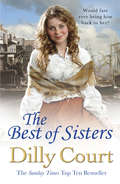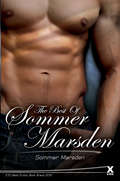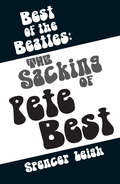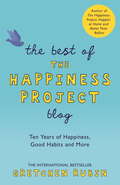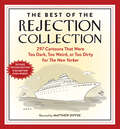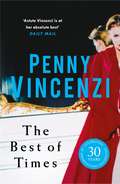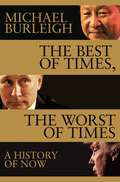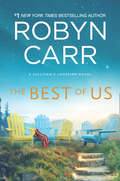- Table View
- List View
The Best of Sisters
by Dilly CourtThe Thames carried him away from her, but would it bring him home...?Twelve-year-old Eliza Bragg has known little in life but the cold, comfortless banks of the Thames. Living above her uncle's chandlery she has grown accustomed to a life of penury and servitude, her only comfort the love and protection of her older brother, Bart. But one day Bart accidentally kills a man and is forced to flee to New Zealand. Alone, barefoot, beaten down and at the mercy of her cruel uncle, Eliza realises that her very survival is at stake...
The Best of Sommer Marsden
by Sommer MarsdenFrom edgy and intense, to light and comedic, this collection of over twenty hand-picked dirty tales runs the gamut of erotic fiction.Stories include a supernatural spurred ménage, a captivating Dom who takes control at a crowded house party, an irresistible alpha who makes recycling kind to the body and the planet. A husband encouraging his wife to take advantage of a girl crush and a woman who can’t help but lose herself between two of her two best friends in a night of passion. A curvaceous woman gets stuck in her boot—that’s right, just one—before an important interview with a handsome applicant and a public spanking makes a young woman reconsider the disposable nature of her rebound guy. Find out why Sommer Marsden’s been called “…one of the top storytellers in the erotica genre” (Violet Blue), “Unapologetic” (Alison Tyler) and “…the whirling dervish of erotica” (Craig J. Sorensen). It’s all right here in this collection. All you have to do is step inside.
Best of the Beatles: The sacking of Pete Best
by Spencer LeighWhy was Pete Best sacked from the Beatles? In this unique book, based on extensive research and interviews with those close to the events, Spencer Leigh has gathered the clues together to try and solve the greatest Beatles mystery of all. On 16 August 1962, the Beatles drummer, Pete Best, went to see their manager, Brian Epstein, in his Liverpool office. He thought that Epstein wanted to discuss future bookings with him but instead, Epstein sacked him. Pete had not seen it coming. Why did Brian Epstein do it and not the Beatles themselves? Why did they want to be rid of him? Why did they do it so callously? Pete never spoke to any of them again. Best of the Beatles: The sacking of Pete Best tells you what really happened and is essential reading for Beatles fans.
The Best of the Best: Becoming Elite at an American Boarding School
by Rubén A. Gaztambide-FernándezFor two years, Rubén Gaztambide-Fernández shared the life of what he calls the “Weston School,” an elite New England boarding school. He sat in on classes, ate meals in the dining halls, cheered at sporting events, hung out in dorms while students baked cookies or celebrated birthdays. And through it all, observing the experiences of a diverse group of students, conducting interviews and focus groups, he developed a nuanced portrait of how these students make sense of their extraordinary good fortune in attending the school. Vividly describing the pastoral landscape and graceful buildings, the rich variety of classes and activities, and the official and unofficial rules that define the school, The Best of the Best reveals a small world of deeply ambitious, intensely pressured students. Some are on scholarship, others have never met a public school student, but all feel they have earned their place as a “Westonian” by being smart and working hard. Weston is a family, they declare, with a niche for everyone, but the hierarchy of coolness—the way in which class, race, sexism, and good looks can determine one’s place—is well known. For Gaztambide-Fernández, Weston is daunting yet strikingly bucolic, inspiring but frustratingly incurious, and sometimes—especially for young women—a gilded cage for a gilded age. “Would you send your daughter here?” one girl asks him, and seeing his hesitation asks, “Because you love her?”
Best of the Best: Feedback
by Isabella Wallace Leah KirkmanIn Feedback, Isabella Wallace and Leah Kirkman explore our understanding of what is often cited as one of the most powerful tools for enhancing learning, drawing together ideas from leading international thinkers and practical strategies for busy teachers. The Best of the Best series brings together - for the first time - the most influential voices in education in a format that is concise, insightful and accessible for teachers. Keeping up with the latest and best ideas in education can be a challenge - as can putting them into practice - but this new series is here to help. Each title features a comprehensive collection of brief and accessible contributions from some of the most eminent names in education from around the world. In this second volume in the series, Wallace and Kirkman have curated a collection of inspiring contributions on the theme of feedback and have developed practical, realistic, cross-curricular and cross-phase strategies to make the most of these important insights in the classroom. Feedback can be understood and implemented in the classroom in a whole range of ways, as Wallace and Kirkman's practical strategies - based on the contributors' expert insights - demonstrate. From these contributions, each unique and enlightening in its own right, a number of key themes emerge. One is the need to get the balance right between praise and constructive critique by keeping feedback specific, detailed and firmly referenced to clearly explained criteria. Another is that these same principles should be applied whether the feedback is from teacher to student, teacher to colleague, student to teacher or student to student. Response to feedback is critical: the need to give students the time to reflect on it, to question it, to act on it. Also important is the manner in which feedback is given: kindly, constructively, in a timely way and in an atmosphere of trust. Above all, whether written or oral, effective feedback is primarily about is clear, constructive and specific communication. Each expert has provided a list of further reading so you can dig deeper into the topic. In addition, the Teacher Development Trust has offered more useful ideas for embedding these insights as part of CPD. Suitable for all educationalists, including teachers and school leaders.
Best of the Best: Engagement (Best Of The Best Ser.)
by Isabella Wallace Leah KirkmanIsabella Wallace and Leah Kirkman’s Engagement is a carefully curated collection of experts’ insights on the theme of teacher and learner engagement, which – as they ably demonstrate – can be facilitated and encouraged in a number of ways. The Best of the Best series brings together – for the first time – the most influential voices in education in a format that is concise, insightful and accessible for teachers. Keeping up with the latest and best ideas in education can be a challenge – as can putting them into practice – but this highly acclaimed series is here to help. Each title features a comprehensive collection of brief and accessible contributions from some of the most eminent names in education from around the world. In this third volume, Wallace and Kirkman explore the core concept of engagement – an essential facet of effective learning both for learners and for teachers – and share practical, realistic, cross-curricular and cross-phase strategies to make the most of these important insights. Engagement, whether of the teacher or the learners, can’t be compelled and will always be contingent on the complexities of motivation. Indeed, it could be argued that it is teacher engagement which is the key to successful learning. Such engagement can be facilitated by encouraging professional dialogue between staff, or it may be that the school’s high expectations alone could encourage in its teachers a sense of professional empowerment. But how do we recognise learner engagement, and what can we do to encourage it? From this compendium of expert voices emerge three important themes: that teachers’ engagement and positive example should be seen as a prerequisite for establishing learner motivation; that learners’ interest needs to be actively engaged, whether by meaningful challenge or by tapping into their natural curiosity; and that an expectation of appropriate behaviour must precede expectations of engagement. In this volume you will find many practical suggestions of ways to apply these ideas both in the classroom and in the staffroom. Each contributor has provided a list of further reading so you can dig deeper into the topic and, in addition, the Teacher Development Trust offer their advice on how to plan effective CPD and responsive changes to practice based on the contributors’ suggestions. Contributors include: Sir Tim Brighouse, Dr Bill Rogers, Vic Goddard, Sue Cowley, Richard Gerver, Andy Cope, Professor Bill Lucas, Ian Gilbert, Professor Susan Wallace, Andy Griffith, Dr Debra Kidd, Conrad Wolfram, Paul Dix, John Davitt, Phil Beadle, Mike Gershon and Professor Mick Waters. Suitable for all educationalists, including teachers and school leaders.
Best of the Best: Feedback (Best Of Best Ser.)
by Isabella Wallace Leah KirkmanIn Feedback, Isabella Wallace and Leah Kirkman explore our understanding of what is often cited as one of the most powerful tools for enhancing learning, drawing together ideas from leading international thinkers and practical strategies for busy teachers. The Best of the Best series brings together – for the first time – the most influential voices in education in a format that is concise, insightful and accessible for teachers. Keeping up with the latest and best ideas in education can be a challenge – as can putting them into practice – but this new series is here to help. Each title features a comprehensive collection of brief and accessible contributions from some of the most eminent names in education from around the world. In this second volume in the series, Wallace and Kirkman have curated a collection of inspiring contributions on the theme of feedback and have developed practical, realistic, cross-curricular and cross-phase strategies to make the most of these important insights in the classroom. Feedback can be understood and implemented in the classroom in a whole range of ways, as Wallace and Kirkman’s practical strategies – based on the contributors’ expert insights – demonstrate. From these contributions, each unique and enlightening in its own right, a number of key themes emerge. One is the need to get the balance right between praise and constructive critique by keeping feedback specific, detailed and firmly referenced to clearly explained criteria. Another is that these same principles should be applied whether the feedback is from teacher to student, teacher to colleague, student to teacher or student to student. Response to feedback is critical: the need to give students the time to reflect on it, to question it, to act on it. Also important is the manner in which feedback is given: kindly, constructively, in a timely way and in an atmosphere of trust. Above all, whether written or oral, effective feedback is primarily about is clear, constructive and specific communication. Each expert has provided a list of further reading so you can dig deeper into the topic. In addition, the Teacher Development Trust has offered more useful ideas for embedding these insights as part of CPD. Suitable for all educationalists, including teachers and school leaders. Contributions include: Professor Dylan Wiliam – Formative assessment: the bridge between teaching and learning; Arthur L. Costa and Robert J. Garmston – A feedback perspective; Professor Bill Lucas – Feedback or feedforward?; Diana Laufenberg – Finding time for feedback; Paul Dix – Wristband peer feedback; Taylor Mali – The sound of silent tears of pride; Ron Berger – Critique and feedback; Andy Griffith – Receiving feedback; Professor Barry Hymer – Praise and rewards: danger – handle with care; Jackie Beere OBE – How can failure help you grow?; Mike Gershon – Target implementation time; Professor Mick Waters – Reward points for teachers; Geoff Petty – The quality learning cycle: feedback for significant progress; Shirley Clarke – Getting underneath the understanding and acting on it; Seth Godin – The four rules of peer feedback; Phil Beadle – Shut up, coach!; Teacher Development Trust – Next steps …
Best of the Best: Progress
by Isabella Wallace Leah KirkmanIn Progress, Isabella Wallace and Leah Kirkman explore our understanding of this core educational concept, drawing together ideas from leading international thinkers and practical strategies for busy teachers. The Best of the Best series brings together – for the first time – the most influential voices in education in a format that is concise, insightful and accessible for teachers. Keeping up with the latest and best ideas in education can be a challenge – as can putting them into practice – but this new series is here to help. Each title features a comprehensive collection of brief and accessible contributions from some of the most eminent names in education from around the world. In this exciting first volume, Isabella Wallace and Leah Kirkman have curated a collection of inspiring contributions on the theme of progress and have developed practical, realistic, cross-curricular and cross-phase strategies to make the most of these important insights in the classroom. Each expert has provided a list of further reading so you can dig deeper as you see fit. In addition, the Teacher Development Trust has outlined ideas for embedding these insights as part of CPD. Suitable for all educationalists, including teachers and school leaders. Many myths abound about progress. We have to show that learners are making progress, but what do we really mean by the term? Who decides what constitutes progress? Who should set targets, and why? How do we measure progress? How do we know when pupils are demonstrating it? How do we differentiate and allow for learners’ different starting points? Should we be measuring everyone against the average or should we be looking at ipsative progress, where achievement is relative only to the pupil’s personal best? Indeed, if everyone is making expected progress, is that really progress or just doing as expected? Do we need to rethink assessment? Does meta-cognition hold the answer? What about other approaches like SOLO taxonomy or Building Learning Power? If progress isn’t linear, what kind of shape does it have? What implicit value judgements may we be making when applying the term uncritically and unthinkingly? How do we ensure that funding, including the Pupil Premium, is having a tangible effect on progress? Can we make learning and progress visible? What does the evidence base – the research studies and meta-analyses – have to say? Will that be applicable in all contexts? These are just some of the questions that the educational experts delve into in this first volume in the Best of the Best series. The practical strategies offered by Isabella Wallace and Leah Kirkman demonstrate how teachers can immediately use these ideas in the classroom. Advice from the Teacher Development Trust demonstrates how to plan sustained and responsive changes to practice based on the book’s key insights. Contributions include: Professor John Hattie – Pupil premium – monitoring what works. Geoff Petty – Improving progress by learning from the best research. Sir John Jones – Demographics, destiny and the magic-weaving business. Sugata Mitra – Schools in the Internet age. David Didau – The real shape of progress. Professor Mick Waters – Doing well for your age? Will Ord – What is progress? Claire Gadsby – A climate for learning. Professor Robert Bjork – Creating desirable difficulties to enhance learning. Professor John West-Burnham – Progress and practice. Professor Guy Claxton – Building Learning Power: finding your own sweet spot. James Nottingham – Progress, progress, progress. Mark Burns – Learning without limits. Martin Robinson – The pupil’s progress. Mike Gershon – Exemplar work. Pam Hook – On making progress visible with SOLO. Andy Hargreaves – Uplifting colleagues. Teacher Development Trust – Next steps …
The Best of the Happiness Project Blog: Ten Years of Happiness, Good Habits, and More
by Gretchen RubinFrom the author of BETTER THAN BEFORE > 'A LOT OF US WOULD LIKE A RUBIN IN OUR LIVES' The Times Magazine - 'EXTRAORDINARY' Viv Groskop, The Times Style - 'FASCINATING, PERSUASIVE' Guardian - 'A LIFE-CHANGER' The PoolDid you love The Happiness Project, Happier at Home and Better Than Before? New York Times bestselling author and award-winning podcaster Gretchen Rubin celebrates ten years of blogging with a special commemorative ebook. This collection offers Gretchen's best articles from a decade of studying happiness and habits. From her first day as a blogger to the happiest day of her life, Rubin relives the moments that have helped us understand our habits, improve our relationships, and lead happier lives. Whether you're a longtime fan who has read Gretchen's recent New York Times bestsellers The Happiness Project, Happier at Home and Better Than Before, or a new convert from her wildly popular podcast, Happier with Gretchen Rubin, this funny and poignant compilation will entertain and inspire you in your own pursuit of happiness and good habits.
The Best of the Rejection Collection: 293 Cartoons That Were Too Dumb, Too Dark, or Too Naughty for The New Yorker
by Matthew DiffeeIt’s the best of the worst: 293 of the funniest cartoons rejected by The New Yorker but luckily for us, now in paperback and available to enjoy. The Rejection Collection brings together some of The New Yorker’s brightest talents—Roz Chast, Gahan Wilson, Sam Gross, Jack Zeigler, David Sipress, and more—and reveals their other side. Their dark side. Their juvenile side. Their sick side. Their naughty side. Their outrageous side.And what a treat. Ventriloquist dummy cartoons. Operating room cartoons. Bring your daughter to work day cartoons (the stripper, the prison guard on death row). Lots of couples in bed, quite a few coffins, wise-cracking animals—an obsessive’s plumbing of the weird, the scary, the off-the-wall, and done so without restraint.Every week The New Yorker receives 500 cartoon submissions, and rejects a great majority—mostly, of course, for not being funny enough. There’s no question why these were rejected, and it’s not for lack of laughs. One can almost hear Eustace Tilley sniffing, We are not amused.
The Best of the Rejection Collection: 297 Cartoons That Were Too Dark, Too Weird, or Too Dirty for The New Yorker
by Matthew DiffeeThe best of the worst: these cartoons rejected by The New Yorker were deemed too dumb, too weird, or too naughty—but not for lack of laughs! Every week, hundreds and hundreds of cartoons pour into The New Yorker. Most are rejected. Doesn&’t matter how big a deal the cartoonist is, either. Roz Chast, David Sipress, Kim Warp, Sam gross, Ed Steed, Emily Flake, Navied Mahdavian, or Mary Lawton—if the work in question is too weird, too naughty, too juvenile, or too dark, it&’s out. Luckily for us, Matthew Diffee has been bravely sifting through the circular file to rescue the best of the worst. Here are 297 cartoons in a revised second edition featuring more than 50 new cartoons—even better, even worse! The cartoon set-ups may be familiar—a couple in bed, a few people stranded on a desert island, a doctor and patient in an examining room—but the joke are anything but, with twists so unexpected, you can&’t help but laugh out loud.
The Best of THE SHOW: A Classic Collection Of Wit And Wisdom
by Bill Scheft"The Show" is the second most widely-read column in Sports Illustrated, after Rick Reilly, who will write one of the book's introductions. Sports Illustrated has over three million subscribers, the third highest magazine circulation in the United States, and is read by 23 million adults each week.- The Best Of "The Show" will appeal to fans of Rick Reilly's Life of Reilly (Total/Sports Illustrated, 2000) and Bill Geist's Fore!Play (Warner, 2001), both of which were bestsellers.- Scheft was the Emmy Award-nominated head monologue writer for David Letterman for 13 years and routinely appears on the air with him. He is a frequent guest on the talk show circuit and on sports radio programs all over the country.
The Best Of The Year - Medical Romance (Mills And Boon Series Collections)
by Marion Lennox Melanie Milburne Carol Marinelli Jennifer Taylor Fiona Lowe Tina Beckett Scarlet Wilson Louisa George Amalie Berlin Robin Gianna Susanne Hampton Karin BaineM&B brings you the very best Medical Romances of 2015 in twelve lovely romances to renew your faith in life – and love! This wonderful collection includes:
The Best Of The Year - Modern Romance: Claimed For The Leonelli Legacy (wedlocked!, Book 88) / The Innocent's Secret Baby / The Prince's Captive Virgin / The Innocent's Shameful Secret / Carrying The Spaniard's Child / The Prince's Nine-month Scandal (Mills And Boon Series Collections #1)
by Lynne Graham Kate Walker Cathy Williams Sharon Kendrick Susan Stephens Abby Green Carol Marinelli Caitlin Crews Maisey Yates Annie West Maya Blake Michelle SmartM&B brings you the most exciting Modern alpha men of 2015! In this sinfully seductive collection, prepare to be swept away by twelve determined, demanding heroes. This includes:
The Best of the Year - Modern Romance 2016 (Mills And Boon Series Collections #1)
by Lynne Graham Cathy Williams Miranda Lee Sharon Kendrick Susan Stephens Jennie Lucas Abby Green Caitlin Crews Kate Hewitt Maisey Yates Julia James Maya Blake12 best books from this year.
The Best of Times: Challenges and Triumphs in British Politi, Economi and Foreign Affairs 2013-2015
by Mark FieldTensions simmer in the aftermath of 2008’s catastrophic financial crash. As the darkest days of the crisis fade behind us, great obstacles to prosperity remain. Mark Field’s acclaimed first book, Between the Crashes, explored the economic collapse. Now, in his new collection of essays, the City of London MP charts our progress as the economy splutters back to life, untangling the rhetoric of deficit reduction from reality, and meaningful reform from political posture.The Best of Times traces the compromises of coalition government and the emergence of a new anti-establishment sentiment, taking in the Scottish independence referendum, UKIP’s rise and fall, and the unexpected genesis of Corbynism. Conflicts in the Middle East open a dark chapter in foreign affairs while, closer to home, a shock Conservative victory in the 2015 general election ensures a hotly debated EU referendum.Yet, for all the surprises delivered by the past three years, today’s challenges are deeply familiar: shifting global power, generational wars and disillusionment with capitalism still threaten our prosperity. Engaging and unflinching, The Best of Times offers erudite analysis and practical solutions to the challenges facing Britain today.
The Best of Times
by Penny VincenziOn a hot summer's day, a lorry slews across a motorway and causes a huge pile-up. In that split-second accident, lives are changed forever.Jonathan is a successful surgeon returning from a liaison with his mistress, Abi; Georgia is a young actress on her way to an audition for the part that could make her career; Toby is a bridegroom travelling to his wedding with his best friend, Barney; Mary is a widow, trying to get to the airport to reunite with her wartime first love, and William is a young farmer who witnesses the crash from across the hill.One incident - and only one person who really knows what happened. THE BEST OF TIMES is an exhilarating, engaging novel of secrets, hopes and worlds that are torn apart.
The Best of Times, The Worst of Times: A History of Now
by Michael BurleighIn the decades since the end of the Second World War, it has been widely assumed that the western model of liberal democracy and free trade is the way the world should be governed. However, events in the early years of the twenty-first century – first, the 2003 war with Iraq and its chaotic aftermath and, second, the financial crash of 2008 – have threatened the general acceptance that continued progress under the benign (or sometimes not so benign) gaze of the western powers is the only way forwards. And as America turns inwards and Europe is beset by austerity politics and populist nationalism, the post-war consensus looks less and less secure. But is this really the worst of times? In a forensic examination of the world we now live in, acclaimed historian Michael Burleigh sets out to answer that question. Who could have imagined that China would champion globalization and lead the battle on climate change? Or that post-Soviet Russia might present a greater threat to the world’s stability than ISIS? And while we may be on the cusp of still more dramatic change, perhaps the risks will – in time – bring not only change but a wholly positive transformation.Incisive, robust and always insightful, The Best of Times, The Worst of Times by Michael Burleigh is both a dazzling tour d’horizon of the world as it is today and a surprisingly optimistic vision of the world as it might become.
The Best Of Us (Sullivan's Crossing #4)
by Robyn CarrNEW YORK TIMES BESTSELLING AUTHOR SULLIVAN’S CROSSING: BOOK FOUR
The Best of Us: A Memoir
by Joyce MaynardThe San Francisco Chronicle's Best of the Year List From New York Times bestselling author Joyce Maynard, a memoir about discovering strength in the midst of great loss--"heart wrenching, inspiring, full of joy and tears and life." (Anne Lamott)In 2011, when she was in her late fifties, beloved author and journalist Joyce Maynard met the first true partner she had ever known. Jim wore a rakish hat over a good head of hair; he asked real questions and gave real answers; he loved to see Joyce shine, both in and out of the spotlight; and he didn't mind the mess she made in the kitchen. He was not the husband Joyce imagined, but he quickly became the partner she had always dreamed of. Before they met, both had believed they were done with marriage, and even after they married, Joyce resolved that no one could alter her course of determined independence. Then, just after their one-year wedding anniversary, her new husband was diagnosed with pancreatic cancer. During the nineteen months that followed, as they battled his illness together, she discovered for the first time what it really meant to be a couple--to be a true partner and to have one. This is their story. Charting the course through their whirlwind romance, a marriage cut short by tragedy, and Joyce's return to singleness on new terms, The Best of Us is a heart-wrenching, ultimately life-affirming reflection on coming to understand true love through the experience of great loss.
Best of Vegan
by Kim-Julie HansenFood is so much more than fuel, and veganism is so much more than a diet. It’s linked to culture, family, memories, and identity. A collection of over 100 plant-based recipes that, together, give readers a bird’s eye view of vegan cuisine and its facets, Best of Vegan is a marvelously versatile glimpse into the world of vegan cuisine.
The Best of Verity Stob: Highlights of Verity Stob's Famous Columns from .EXE, Dr. Dobb's Journal, and The Register
by Verity Stob* Verity Stob is a very popular column throughout the IT sector. * Think: "Monty Python" and "The Office" meet IT!! * Many of the columns haven’t been available to the public since .EXE stopped publishing .
The Best of Wilmott 1: Incorporating the Quantitative Finance Review
by Paul WilmottNovember 11th 2003 saw a landmark event take place in London. As the first conference designed for quants by quants the Quantitative Finance Review 2003, moved away from the anonymous bazaars that have become the norm, and instead delivered valuable information to market practitioners with the greatest interest. The roster of speakers was phenomenal, ranging from founding fathers to bright young things, discussing the latest developments, with a specific emphasis on the burgeoning field of credit derivatives. You really had to be there. Until now, at least. The Best of Wilmott 1: Including the latest research from Quantitative Finance Review 2003 contains these first-class articles, originally presented at the QFR 2003, along with a collection of selected technical papers from Wilmott magazine. In publishing this book we hope to share some of the great insights that, until now, only delegates at QFR 2003 were privy to, and give you some idea why Wilmott magazine is the most talked about periodical in the market. Including articles from luminaries such as Ed Thorp, Jean-Philippe Bouchaud, Philipp Schoenbucher, Pat Hagan, Ephraim Clark, Marc Potters, Peter Jaeckel and Paul Wilmott, this collection is a must for anyone working in the field of quantitative finance. The articles cover a wide range of topics: * Psychology in Financial Markets * Measuring Country Risk as Implied Volatility * The Equity-to-Credit Problem * Introducing Variety in Risk Management * The Art and Science of Curve Building * Next Generation Models for Convertible Bonds with Credit Risk * Stochastic Volatility and Mean-variance Analysis * Cliquet Options and Volatility Models And as they say at the end of (most) Bond movies The Best of Wilmott... will return on an annual basis.
The Best of Wilmott 2
by Paul WilmottThe Team at Wilmott is very proud to present this compilation of Wilmott magazine articles and presentations from our second year. We have selected some of the very best in cutting-edge research, and the most illuminating of our regular columns. The technical papers include state-of-the-art pricing tools and models. You'll notice there's a bias towards volatility modelling in the book. Of course, it's one of my favourite topics, but volatility is also the big unknown as far as pricing and hedging is concerned. We present research in this area from some of the best newcomers in this field. You'll see ideas that make a mockery of 'received wisdom,' ideas that are truly paradigm shattering - for we aren't content with a mere 'shift.' We know you'll enjoy it! The Best of Wilmott will return again next year...
The Best of Windows 7 Secrets
by Paul Thurrott Rafael RiveraThe Best of Windows 7 Secrets delivers a concise and value-packed punch that includes the most important Windows 7 features that all Windows 7 users need to know. This Kindle-only ebook delivers the most important content on this major Microsoft upgrade to value-minded Kindle book buyers. Written by well-known Windows experts and excerpted from best-selling Windows 7 Secrets, this book is the go-to guide for every Windows 7 user with a Kindle. The lead author Paul Thurrott runs the SuperSite for Windows (WinSuperSite.com), which has been described by Microsoft as the most influential Windows-oriented Web site in the world. Paul is joined by Rafael Rivera the blogger and programmer behind Within Windows (WithinWindows.com), a blog devoted to the technical internals of Microsoft's Windows operating systems.
